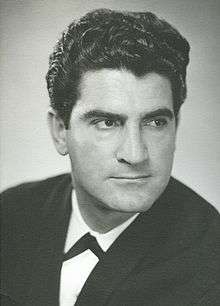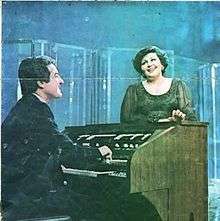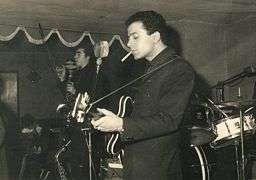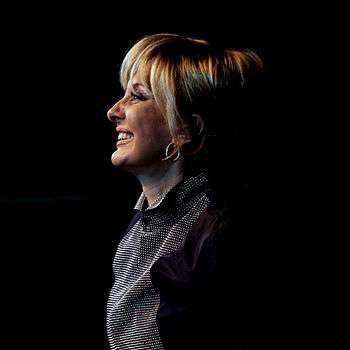Iranian pop music
| Music of Iran | |
|---|---|
| General topics | |
| Genres | |
| Specific forms | |
| Media and performance | |
| Music awards | Musicema Awards |
| Music festivals | |
| Music media |
|
| Nationalistic and patriotic songs | |
| National anthem |
|
| Other | |
| Regional music | |
Iranian pop music refers to pop music originated in Iran, with songs mainly in Persian and other regional languages of the country.
History
Early Iranian popular music
The origin of Iranian pop music dates back to the time of the 19th-century Qajar dynasty.[1] Following the invent of radio in 1930, and after World War II, a form of popular music emerged and began to develop in Iran.

1950s–60s
Persian pop music grew and developed during the 1950s. Different types of pop music, including rumba, tango and waltz music, were also developed during this period.
Viguen, known as "the Sultan of Persian Pop and Jazz", was one of the most prominent and successful artists who emerged by the beginning of this period.[2] He was of Armenian origin, and sang in both Persian and Armenian.
1970s
By the 1970s, a new wave was formed in Iranian pop music, using indigenous instruments and adding electric guitar and other imported characteristics.
Among the most famous and notable singers who emerged during this period were Andranik Madadian, Aref, Dariush Eghbali, Ebi, Faramarz Aslani, Farhad, Giti Pashaei, Googoosh, Hassan Shamaizadeh, Haydeh, Homeyra, Leila Forouhar, Mahasti, Nooshafarin, Ramesh, and Shahram Shabpareh.
Parviz Maghsadi and Varoujan Hakhbandian were among pioneer composers who wrote and composed songs for famous singers such as Viguen, Googoosh, Dariush, and Farhad.[3]
 Maghsadi Band — Left to right: Onik, Dariush, Parviz, Keyvan, Masis, and Neli. (1960s)
Maghsadi Band — Left to right: Onik, Dariush, Parviz, Keyvan, Masis, and Neli. (1960s) Haydeh and Anoushirvan on the Iranian National Television, in 1975.
Haydeh and Anoushirvan on the Iranian National Television, in 1975. Young Farhad playing guitar. He was one of the most influential Iranian pop and rock singers since the 1960s.
Young Farhad playing guitar. He was one of the most influential Iranian pop and rock singers since the 1960s. Googoosh, a leading artist from this period who continued her career.
Googoosh, a leading artist from this period who continued her career.
After the 1979 Revolution
After the 1979 Revolution, pop music was banned and completely disappeared from the scene in Iran.[4]
Many Iranians immigrated to foreign countries, especially to Los Angeles in the United States, and many continued to sing in exile. Since then, several popular Iranian TV channels and radio stations operate outside of the country, aired through various satellites. These broadcast companies play an important role in promoting and connecting Iranian pop artists to Iranians living all over the world.[5]
In the 1990s, officials of the new government decided to produce and promote a "decent" pop music, in order to compete with the abroad and unofficial sources of Iranian music. Ali Moallem (poet)[6] and Fereydoun Shahbazian (musician) headed a council at the IRIB that supervised the revival of domestic pop music.[7]
Shadmehr Aghili was one of the first post-revolutionary Iranian singers who received significant support, including promotion by national television, to produce new Persian pop songs inside Iran. He was highly skilled at playing violin and guitar, and was a very talented singer. He became a very successful and popular musician and singer in Iran, but eventually immigrated to Canada and then moved to Los Angeles, continuing his career outside of Iran.
Under the presidency of Khatami, as a result of easing cultural restrictions within Iran, a number of new pop singers emerged from within the country.[8][4] Since the new administration took office, the Ministry of Ershad adopted a different policy, mainly to make it easier to monitor the industry. The newly adopted policy included loosening restrictions for a small number of artists, while tightening it for the rest. However, the number of album releases increased.
Arian, the first officially sanctioned pop music band with female singers in post-revolutionary Iran, started a new chapter of Iranian pop music.[9] They had a cooperation with the well-known British-Irish singer Chris de Burgh in their fourth album Bi to, Ba to,[10] and were the first Iranian band to be featured in the English biographical dictionary and directory of International Who's Who in Music.
In late 2009, Sirvan Khosravi became the first domestic Iranian artist to achieve high-rotation airplay on a regular European radio station.[11] He made his debut with the song Saat-e 9 ("9 O'Clock"),[12] which also made headlines in Iranian online media.[13] In August 2010, Farzad Farzin made his debut European chart with the song Chike Chike ("Trickle Trickle") from his third legal album Shans ("Chance").[14]
Awards
Notable International Awards
- 1971: Googoosh, first prize and golden record at the MIDEM in Cannes, for her 7th record (as Gougoush) featuring two songs in French:
"Retour de la Ville" (A-side) and "J'entends Crier Je T'aime" (B-side). - 1972: Googoosh, first prize at the Carthage Music Festival.
- 1972: Googoosh, first medal of arts of Tunisia.
- 1973: Googoosh, participated at the Sanremo Music Festival.[15]
- 2002: Deep Dish, Grammy Award winner for Best Remixed Recording, for Dido's "Thank You".
- 2006: Andy Madadian, Best Middle Eastern Song & Best Middle Eastern Album at JPF Awards.
- 2013: Farzad Farzin, Best Song and Performance at the Art-football Festival.
See also
References
- ↑ "Pop Music in Iran". 2003.
- ↑ Saba, Sadeq (Oct 27, 2003). "Iranian pop legend dies at 74". BBC News. BBC News. Retrieved Aug 18, 2014.
- ↑ نتایج برای جستجوی : واروژان (in Persian). Kasbarg.com. Retrieved 2009-02-21.
- 1 2 "Rock Rolls Once More in Iran As Hard-Liners Back Pop Revival". The Wall Street Journal. 2 June 2000. Retrieved 9 April 2010.
- ↑ "Submitting tips for TV broadcast". pmc.tv.
- ↑ Ali Moallem on Pop music
- ↑ An interview with Fereydoun Shahbazian
- ↑ "Roll Over, Khomeini! Iran Cultivates A Local Rock Scene, Within Limits". The Washington Post. 23 August 2001. Retrieved 9 April 2010.
- ↑ BBC News (December 2004). "Iran's first pop revolutionaries". Retrieved 2008-04-10.
- ↑ "Chris de Burgh to play 'cheek to cheek' with Iranian band in Tehran". The Telegraph Media Group. 28 July 2008.
- ↑ "Iraanse popster Sirvan Khosravi deze week de diXte of FunX Radio". FunX (Radio network).
- ↑ "Sirvan Khosravi - Saate 9 (Review)". Bia2.com.
- ↑ "آهنگ «ساعت 9» سیروان؛ رتبهی اول چارت رادیوی هلندی شد". Musicema.
- ↑ "FunX XTips Chart". FunX (Radio network).
- ↑ Bahmani, Behrouz (February 11, 2003). "A Treasure Hunter's Efforts Pay Off, An Album of Long Lost Googoosh Songs, San Remo 73". The Iranian. Retrieved October 9, 2014.